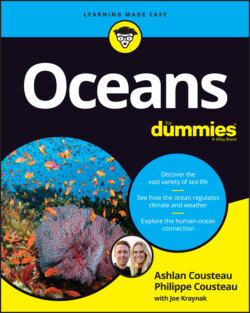Читать книгу Oceans For Dummies - Joseph Kraynak - Страница 60
The Cretaceous period
ОглавлениеLife literally started to bloom during the Cretaceous period (145 to 66 million years ago), during which time flowers first appeared in the form of a genus of plants known as Archaefructus. Of course, plenty of other activity was going on as well:
Tyrannosaurids (early tyrannosaurus relatives) evolved.
Ceratopsians (those dinosaurs that look like rhinos) grew their head gear.
Several awesome dinosaurs stepped on stage, including: Ankylosaurs (sort of a cross between a horned toad and an armadillo), titanosaurs (the reptile version of a giraffe), hadrosaurs (hard to describe), and azhdarchids (giant flying pterosaurs).
Mosasaurs appeared, looking like a cross between a whale and an alligator.
Rays and modern sharks became common.
Hesperornithes (flightless birds that look like penguins but with longer necks) evolve.
Near the end of the Cretaceous period, species diversity was low and things were going to get worse with the Cretaceous-Paleogene (K-Pg) Extinction event, also known as the Cretaceous-Tertiary (K-T) Extinction, probably caused by the famous asteroid that killed all the dinosaurs. As the story goes, a mountain-sized asteroid hit the gulf of Mexico, spewing ash and blocking sunlight, causing a serious cold spell. Gases also affected the land and ocean resulting in the death of plants and collapse of ecosystems. This period is also responsible for some of the largest volcanic eruptions in history, lasting for tens of thousands of years (yikes!). All ichthyosaurs, plesiosaurs, and mosasaurs went extinct. Plankton populations collapsed, causing food webs to disintegrate. All in all, about 75 percent of the world’s species were wiped out.
